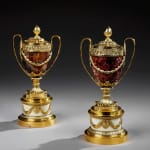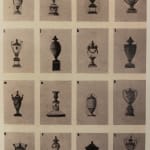WORKS FOR SALE
A PAIR OF GEORGE III ORMOLU-MOUNTED BLUE JOHN URNS ATTRIBUTED TO MATTHEW BOULTON
Height: 23.5cm 9.25 "
Provenance
Private Collection: Paris, France
Literature
18th Century English Furniture. The Norman Adams Collection. pg 456
Mallett Millennium. Fine Antique Furniture & Works of Art. Lanto Synge . pg 179
N. Goodison, Ormolu, The Work of Matthew Boulton, London, 1974, pl.163
Publications
Matthew Boulton Pattern book I pl. 170. ( See pattern 'P' for comparison to present example)
Illustrated in N. Goodison, Ormolu, The Work of Matthew Boulton, London, 1974, pl.163
A fine pair of George III Ormolu mounted Blue John perfume burners, standing on white marble bases, below Blue John shaped urns mounted with ormolu swags.
Boulton’s family originally produced silver toys, he even managed to establish an Assay office in Birmingham after petitioning in parliament, much to the chagrin of the London Goldsmiths. In the 1770s Matthew Boulton started making Ormolu (originally a French speciality) vases inspired by classical Greek works. Among his clientele was Catherine the Great and Queen Charlotte, wife of George III.
The pattern for the base of these perfume burners appear in at least four designs from Boulton’s metal work pattern book that is preserved in the Birmingham city museum.
Another pair of this classic form of burners is in the collection at Harewood House, Yorkshire.
DISCUSSION
Boulton's designs were inspired by the classical world. Previous decades saw renowned cabinet makers such as William Kent, Thomas Chippendale, Chippendale the Younger and Robert Adam, push the boundaries, and use the classical and natural world as inspiration for there designs. This common theme allows Boulton's work to naturally and organically compliment the furniture.
If one looks at the individual components of the urns, we see a lot of symmetry to the cabinet makers furniture commissions. For example the husks draped over the blue John was often a motif carved in to furniture. We also see carved husks, acanthus and similarly carved patarae, all of these components are depicted on the urns and much of Boulton's work.
This is one of the desgin reasons, that Boulton's ornaments looks so good on mid to late 18th Century furniture, and think that it was a conscious decision taken by Boulton when designing his pieces.
The contrast between the deep, dark richness of mahogany contrasts well with the glinting ormolu and slightly subtler tones of the blue John and the warm coloured marble. While on gilded tables with marble tops, Boulton’s work also works aesthetically well, with the stone and marble work, working in tandem.
The proportion of Boulton's work is another facet to their suitability to furniture from the mid 18th Century. His pieces have a presence and elegance, with out ever overpowering the pieces they are on.
The urns are a classic original design, and this design would have gone a long way in establishing his reputation as a master of ormolu and ornaments. From this design other pieces and designs flourished, but this was the original and what would have ingratiated him to wealthy patrons.



